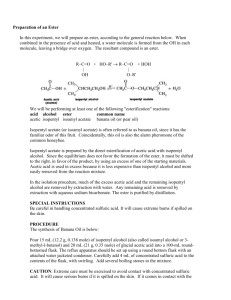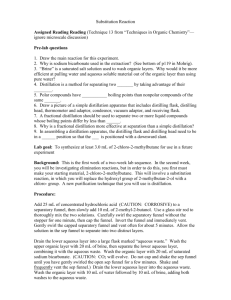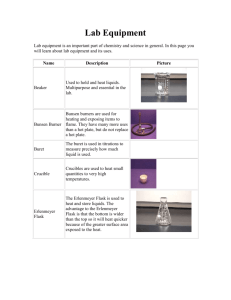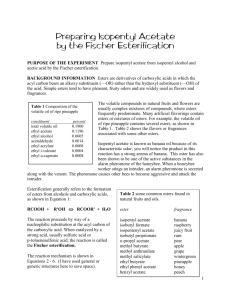Banana Oil Synthesis
advertisement
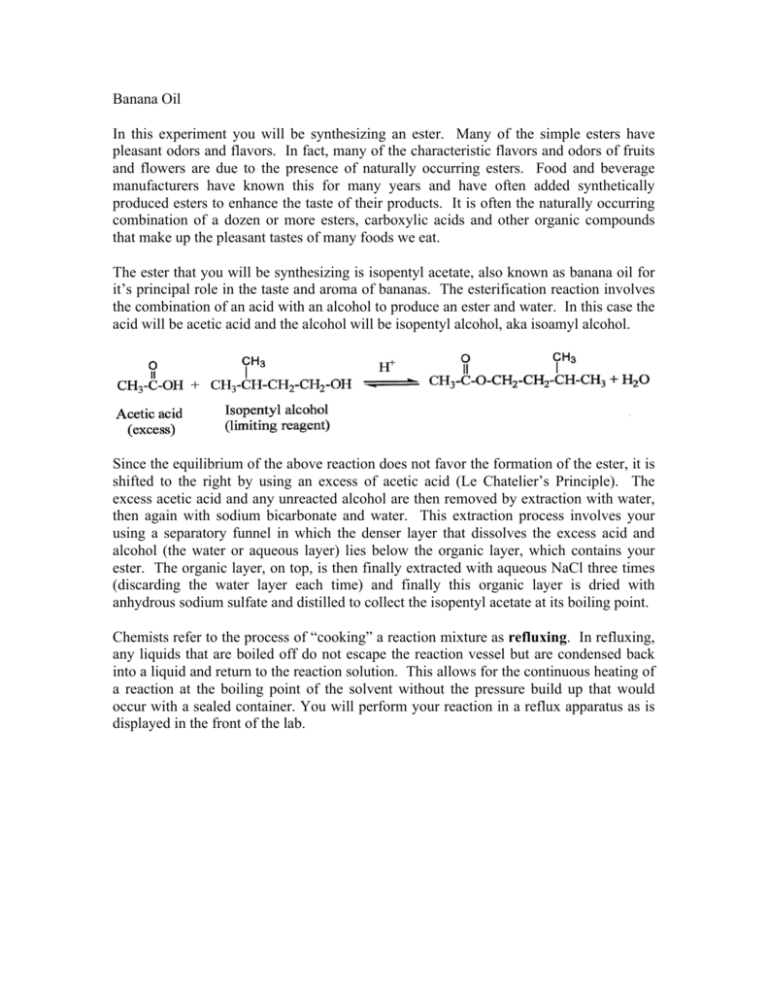
Banana Oil In this experiment you will be synthesizing an ester. Many of the simple esters have pleasant odors and flavors. In fact, many of the characteristic flavors and odors of fruits and flowers are due to the presence of naturally occurring esters. Food and beverage manufacturers have known this for many years and have often added synthetically produced esters to enhance the taste of their products. It is often the naturally occurring combination of a dozen or more esters, carboxylic acids and other organic compounds that make up the pleasant tastes of many foods we eat. The ester that you will be synthesizing is isopentyl acetate, also known as banana oil for it’s principal role in the taste and aroma of bananas. The esterification reaction involves the combination of an acid with an alcohol to produce an ester and water. In this case the acid will be acetic acid and the alcohol will be isopentyl alcohol, aka isoamyl alcohol. Since the equilibrium of the above reaction does not favor the formation of the ester, it is shifted to the right by using an excess of acetic acid (Le Chatelier’s Principle). The excess acetic acid and any unreacted alcohol are then removed by extraction with water, then again with sodium bicarbonate and water. This extraction process involves your using a separatory funnel in which the denser layer that dissolves the excess acid and alcohol (the water or aqueous layer) lies below the organic layer, which contains your ester. The organic layer, on top, is then finally extracted with aqueous NaCl three times (discarding the water layer each time) and finally this organic layer is dried with anhydrous sodium sulfate and distilled to collect the isopentyl acetate at its boiling point. Chemists refer to the process of “cooking” a reaction mixture as refluxing. In refluxing, any liquids that are boiled off do not escape the reaction vessel but are condensed back into a liquid and return to the reaction solution. This allows for the continuous heating of a reaction at the boiling point of the solvent without the pressure build up that would occur with a sealed container. You will perform your reaction in a reflux apparatus as is displayed in the front of the lab. Procedure Weigh (tare) an empty graduated cylinder and record its weight. (You may, alternatively, use the electronic balance that automatically subtracts the tare weight.) Pour approximately 5.0 mL of isopentyl alcohol into the graduated cylinder and weigh it to determine the exact weight (four decimal places) of the alcohol. Record the weight. Remove the round bottom flask of the reflux apparatus and pour the alcohol that is in the cylinder into the flask. Without cleaning the graduated cylinder, pour 7.0 mL of glacial acetic acid into the cylinder and add it to the alcohol in the flask. (TAKE CARE WHEN HANDLING GLACIAL ACETIC ACID AND CONCENTRATED SULFURIC ACID. IF IT GETS ON YOUR SKIN, IMMEDIATELY WASH IT OFF WITH LARGE AMOUNTS OF WATER.) Measure 1 mL of concentrated sulfuric acid with a Pasture pipette and also add it to the flask while gently swirling the flask to mix the three components. Add a corundum boiling chip to the flask and reattach the flask to the reflux apparatus. Allow water to slowly circulate in the condenser, turn up the voltage on the heating mantle so that the mixture starts to boil and continue heating under reflux fro 60-75 minutes. Then turn off or remove the heating mantle and allow the mixture to cool to room temperature. While you’re waiting, set up a ring stand to hold the separatory funnel (see the set up a the front of the lab.) The white stopcock should be in the horizontal position so that it is closed. When the cooling is complete carefully take apart the reflux apparatus. Remove the ground glass stopper from the separatory funnel and pour the contents of the round bottom flask into the top of the separatory funnel (try not to transfer the boiling stone.) Add 10 mL of water to the funnel, then cap the funnel with the ground glass stopper and carefully shake the funnel while frequently venting it while in the upside-down position. (To vent turn the stopcock to the vertical position while the funnel is inverted. Also, make sure to return the stopcock to the closed position before shaking again.) Let the solution settle and the two phases separate. Place the funnel in the ring stand. Remove the ground glass stopper and let the lower, aqueous layer slowly drain into a beaker. You may discard the contents of the beaker only if you are sure that contains the lower, aqueous layer. For your second extraction you will add 5 mL portions of 5% aqueous sodium bicarbonate to the separatory funnel, shaking the funnel between additions, until the mixture is basic to litmus. Now extract the organic layer exactly as you did before, removing the lower aqueous layer. Finally, do a third extraction, this time using 5 mL of saturated aqueous sodium chloride solution. There is a small amount of water in the organic later in what we now refer to as the “crude ester”. It can be removed y transferring the crude ester to a clean, dry 25 mL Erlenmeyer flask and adding approximately 1 gram of anhydrous sodium sulfate. Place a cork into the flask and allow it to stand for 10-15 minutes while you set up the distillation apparatus. (Observe the model distillation set-up in the front of the laboratory.) If the solution still looks cloudy or any droplets of water are visible, transfer the crude ester into a new clean, dry flask and allow it to stand with the addition of about another half gram of anhydrous sodium sulfate. Before starting the distillation weigh a small round bottom or Erlenmeyer flask in which you will collect your product. Record its weight. Then the collection flask should be placed in an ice bath at the end of the distillation apparatus to ensure condensation and reduce odors in the laboratory. Look up the boiling point of isopentyl acetate in the Handbook of Chemistry and Physics. This is the approximate temperature to collect your product. Five degrees above and below the literature value should give you a pure product to collect. Continue to distill until only a drop or two remains in the distilling flask. In your notebook, record the observed boiling range and note of any odor you smell. Weigh your final product and use this weight to calculate the percent yield of your reaction. Bring your product into the instrument room, carefully prepare a salt plate containing your product and under guidance of the College Laboratory Technician obtain its infrared spectrum using the IR spectrometer. Record the name and model of the spectrometer. Compare the spectrum of your product with that of the alcohol reactant which will be given to your by the technician. Write on the graph printout the identity of two or three peaks that characterize the identity of your product and do the same for the isopentyl alcohol.
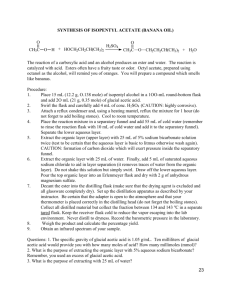
![Isopentyl Acetate [Banana Oil] In this experiment, we prepare an](http://s3.studylib.net/store/data/008730431_1-27d60b2e4c34d7ce18e86c4d6c41e860-300x300.png)
